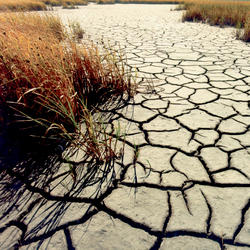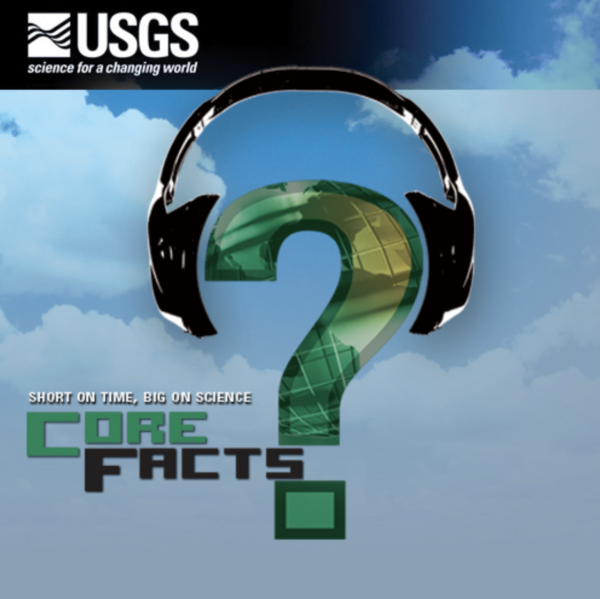Sea surface temperature differences on March 1, 2016. Dark red indicates much warmer water.
What is "El Niño" and what are its effects?
The term El Niño (Spanish for 'the Christ Child') refers to a warming of the ocean surface, or above-average sea surface temperatures, in the central and eastern tropical Pacific Ocean. The low-level surface winds, which normally blow from east to west along the equator (“easterly winds”), instead weaken or, in some cases, start blowing the other direction (from west to east or “westerly winds”). El Niño recurs irregularly, from two years to a decade, and no two events are exactly alike. El Niño events can disrupt normal weather patterns in the United States and globally.
Although the USGS doesn’t directly study or forecast the weather (our sister agency, NOAA, and its National Weather Service do), the USGS studies and documents the effects and impacts of long-term climate changes and weather phenomena across the U.S. and globally.
Related
Does an increase in the 100-year flood estimate originate from climate or land-use change?
How are floods predicted?
How can a 1,000-year rainfall not result in a 1,000-year flood?
What is a 1,000-year flood?
Can major landslides and debris flows happen in all areas of the U.S.?
What is a landslide and what causes one?
How can climate change affect natural disasters?
What are some of the signs of climate change?
What is the difference between weather and climate change?
Sea surface temperature differences on March 1, 2016. Dark red indicates much warmer water.
Bluff erosion during the 2009–10 El Niño undermined the Great Highway guardrail at Ocean Beach, San Francisco, California. The shoreline eroded, on average, 55 meters that winter, leading to lane closures on the highway and an emergency $5-million revetment along the base of this bluff.
Bluff erosion during the 2009–10 El Niño undermined the Great Highway guardrail at Ocean Beach, San Francisco, California. The shoreline eroded, on average, 55 meters that winter, leading to lane closures on the highway and an emergency $5-million revetment along the base of this bluff.
Bluff erosion during the 2009–10 El Niño undermined the Great Highway guardrail at the southern end of Ocean Beach, San Francisco, California. The shoreline eroded, on average, 55 meters that winter, leading to lane closures on the highway and an emergency $5-million revetment along the base of this bluff. Photo taken by Jeff Hansen, USGS, 20 January 2010.
Bluff erosion during the 2009–10 El Niño undermined the Great Highway guardrail at the southern end of Ocean Beach, San Francisco, California. The shoreline eroded, on average, 55 meters that winter, leading to lane closures on the highway and an emergency $5-million revetment along the base of this bluff. Photo taken by Jeff Hansen, USGS, 20 January 2010.
Severe coastal bluff erosion, along the southern end of Ocean Beach, San Francisco, California. This storm damage occurred during the 2009-2010 El Niño, which, on average, eroded the shoreline 55 meters that winter.
Severe coastal bluff erosion, along the southern end of Ocean Beach, San Francisco, California. This storm damage occurred during the 2009-2010 El Niño, which, on average, eroded the shoreline 55 meters that winter.
 (Trailer) Riding the Storm—Landslide Danger in San Francisco Bay Area
(Trailer) Riding the Storm—Landslide Danger in San Francisco Bay Area
Video Highlights:
* A catastrophic 1982 rainstorm triggered 18,000 landslides in the Bay Area, claiming 25 lives and causing $66 million in property damage
* The combination of steep slopes, weak rocks, and intense winter storms make Bay Area uplands an ideal setting for landslides
Video Highlights:
* A catastrophic 1982 rainstorm triggered 18,000 landslides in the Bay Area, claiming 25 lives and causing $66 million in property damage
* The combination of steep slopes, weak rocks, and intense winter storms make Bay Area uplands an ideal setting for landslides
Assessing hazards along our Nation's coasts
U.S. Geological Survey natural hazards science strategy— Promoting the safety, security, and economic well-being of the Nation
Overview of the ARkStorm scenario
Water-the Nation's Fundamental Climate Issue A White Paper on the U.S. Geological Survey Role and Capabilities
Riding the storm--landslide danger in the San Francisco Bay Area
El Nino storms erode beaches on Monterey Bay, California
Related
Does an increase in the 100-year flood estimate originate from climate or land-use change?
How are floods predicted?
How can a 1,000-year rainfall not result in a 1,000-year flood?
What is a 1,000-year flood?
Can major landslides and debris flows happen in all areas of the U.S.?
What is a landslide and what causes one?
How can climate change affect natural disasters?
What are some of the signs of climate change?
What is the difference between weather and climate change?
Sea surface temperature differences on March 1, 2016. Dark red indicates much warmer water.
Sea surface temperature differences on March 1, 2016. Dark red indicates much warmer water.
Bluff erosion during the 2009–10 El Niño undermined the Great Highway guardrail at Ocean Beach, San Francisco, California. The shoreline eroded, on average, 55 meters that winter, leading to lane closures on the highway and an emergency $5-million revetment along the base of this bluff.
Bluff erosion during the 2009–10 El Niño undermined the Great Highway guardrail at Ocean Beach, San Francisco, California. The shoreline eroded, on average, 55 meters that winter, leading to lane closures on the highway and an emergency $5-million revetment along the base of this bluff.
Bluff erosion during the 2009–10 El Niño undermined the Great Highway guardrail at the southern end of Ocean Beach, San Francisco, California. The shoreline eroded, on average, 55 meters that winter, leading to lane closures on the highway and an emergency $5-million revetment along the base of this bluff. Photo taken by Jeff Hansen, USGS, 20 January 2010.
Bluff erosion during the 2009–10 El Niño undermined the Great Highway guardrail at the southern end of Ocean Beach, San Francisco, California. The shoreline eroded, on average, 55 meters that winter, leading to lane closures on the highway and an emergency $5-million revetment along the base of this bluff. Photo taken by Jeff Hansen, USGS, 20 January 2010.
Severe coastal bluff erosion, along the southern end of Ocean Beach, San Francisco, California. This storm damage occurred during the 2009-2010 El Niño, which, on average, eroded the shoreline 55 meters that winter.
Severe coastal bluff erosion, along the southern end of Ocean Beach, San Francisco, California. This storm damage occurred during the 2009-2010 El Niño, which, on average, eroded the shoreline 55 meters that winter.
 (Trailer) Riding the Storm—Landslide Danger in San Francisco Bay Area
(Trailer) Riding the Storm—Landslide Danger in San Francisco Bay Area
Video Highlights:
* A catastrophic 1982 rainstorm triggered 18,000 landslides in the Bay Area, claiming 25 lives and causing $66 million in property damage
* The combination of steep slopes, weak rocks, and intense winter storms make Bay Area uplands an ideal setting for landslides
Video Highlights:
* A catastrophic 1982 rainstorm triggered 18,000 landslides in the Bay Area, claiming 25 lives and causing $66 million in property damage
* The combination of steep slopes, weak rocks, and intense winter storms make Bay Area uplands an ideal setting for landslides















